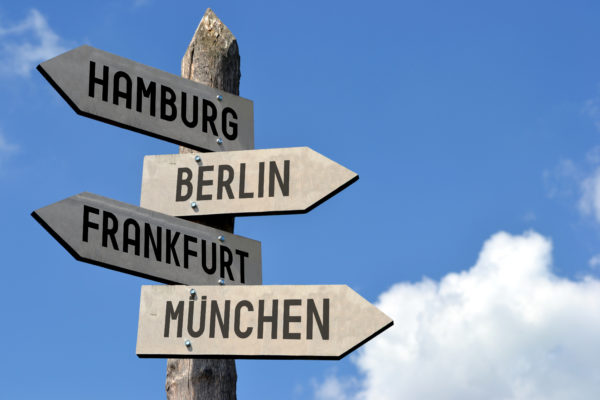
Status quo Automated route optimisation: The differences are considerable!
… and decide on the success or failure of your investment.
When choosing a Transport Management System (TMS) for land transport, can you leave out the topic of automated route optimisation, as this function is offered in every TMS solution anyway? Not at all. The differences between the individual solutions are considerable and have a significant influence on the ROI of your investment. If this is important to you, you should read on!
Bild: iStockphoto
Why are the differences so significant?
The use of the term “automation” does not allow any conclusions to be drawn about the degree of automation and thus the added value achieved. For example, it is quite correct for a provider to talk about automated route optimisation when automatically combining orders from a postcode area. However, the benefits and cost savings are fundamentally different from the split-second distribution of the entire order pool to a vehicle pool calculated by algorithms.
The challenge for buyers and decision-makers is therefore to know their own – future-oriented – needs and to recognise the required functionality in the TMS solutions on offer.
Types of automation
In order to illustrate the differences in quality of automation types, you will find below a rough description of the automations commonly used today – with references to important quality features. This list does not claim to be complete. TMS solutions usually use a combination of different types of optimisation.
Automated assignments to delivery areas (via postcode or polygon)
This includes simple assignments such as grouping orders into geographical delivery areas. These can be postcode-based areas or “painted” polygon-based regions. In the case of postcode-based areas, an assignment to a delivery area is made on the basis of the first digits of the postcode. In the case of polygon-based regions, a simple mathematical formula is used to check in which region the address is located and then it is assigned accordingly.
As a rule, there are no qualitative differences in the automation via the postcode, since the assignment can be done with a few database commands. However, if geocoding (conversion of an address into a format that can be used by computers; geocoordinate) of the address is carried out in the assignment, strong quality differences are possible.
The well-known commercial providers hardly differ in this respect. When using open source-based data/services, however, it is essential to carry out tests in your own delivery area beforehand, as the data collected by the community is incomplete or incorrect in some regions. This can easily lead to a delivery address being assigned to the wrong delivery area.
Sequence optimisation
Based on the type of automation described above and/or via manual scheduling, the scheduler has combined orders into tours. These must now be put in an optimal order. The less a TMS supports, the more the dispatcher runs the risk of receiving incorrect, unacceptable tours as a result.
This content is particularly important.
- Road network (not as the crow flies)
- Road restrictions (length, width, height, weights, dangerous goods class, …)
- Vehicle-related restrictions (loading ramp, forklift, …)
- Driver-related restrictions and social regulations (skills, driving and rest times, …)
- Opening hours (receiver, depot, …)
Many of today’s TMS only support part of the above.
Distance matrix
A distance matrix is a pre-calculated data collection of distances from all addresses to all addresses in a service area. There are static distance matrices and dynamically calculated distance matrices. Static distance matrices are usually based on postcode (5, 3 or even only 2 levels in) and are correspondingly inaccurate. Dynamic distance matrices are usually calculated on the basis of an address on the road network. They are characterised by the fact that when the solution is started, the relevant distances are pre-calculated, temporarily stored and supplemented if necessary.
On the basis of a distance matrix, information can be made visible to the dispatcher quickly and automatically, which makes it easier for him to create tours manually. However, it should be noted that distance matrices based on postcodes are significantly less accurate than distance matrices based on addresses.
In certain applications, a distance matrix can also be replaced by very fast route planning. The route planners offered on the market for this purpose are usually based on pre-calculated nodes in a road network and have no significant disadvantage compared to the address-specific distance matrix.
Bild: iStockphoto
Tour optimisation with algorithms
In the discipline of automated route optimisation, algorithms are used to calculate the distribution of the entire order pool to a vehicle pool (own or third-party vehicles) almost completely automatically. The dispatcher only intervenes if the algorithm could not allocate something. In day-to-day operations, these solutions usually offer the possibility of automatically assigning orders that come in at short notice to a tour that can take over the new order (or several orders) most cost-effectively.
There are also gross differences in quality in tour optimisation. These are partly due to the algorithm used and/or its integration. Another important part is the quality of the underlying data:
- Road network data basis: Similar to sequence optimisation, it is important that an optimisation for HGVs is also calculated on a road network with HGV restrictions.
- Many route optimisations do not do this. They are based on inaccurate distance matrices, on car routings (Google Maps, Open Street Maps etc.) or even air line distances.
- Basis own data: The algorithm cannot take into account what it does not know. Accordingly, it is important that as much (or better all) relevant data as possible is available in the TMS system. This includes delivery dependencies as well as driving and rest times.
- Different goods and different types of vehicles cannot always be optimally calculated with the same algorithm. Providers with several algorithms have advantages here.
The best solution
The best solution is the one that meets your future needs. Companies with few vehicles or few scheduled orders have very different needs than companies with many vehicles/orders. However, the greater the number of vehicles/orders scheduled, the more important is the degree of automation of a solution, as this can offer a significant contribution to cost savings and time savings. Therefore, it is first important that you know what you need or want to achieve.
If one of your needs is the fully automated scheduling of all your orders to all your (or other) vehicles at the click of a mouse, you should take a very close look at whether and to what degree of accuracy the solution meets your needs.
The vast majority of TMS solutions offer at most sequence optimisation with orders that have been roughly summarised beforehand or are based on car-based planning, which can be expensive afterwards. There are very few solutions that can really offer complete automatic route optimisation for trucks.
And another tip: Use your power as a customer. Do you already have a TMS solution, but unfortunately it does not offer fully automated route optimisation? Or have you found a great TMS solution that can support your entire process, but unfortunately it does not have fully automated route optimisation? As a rule, the providers know each other. Take advantage of this and bring your preferred providers together. Together they can probably offer you the best solution for you.
This post originally appeared on LinkedIn Pulse in August 2019 in a slightly different form.



